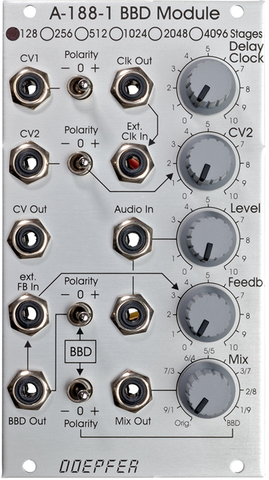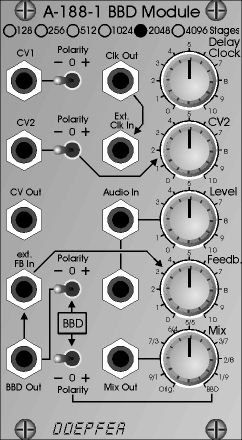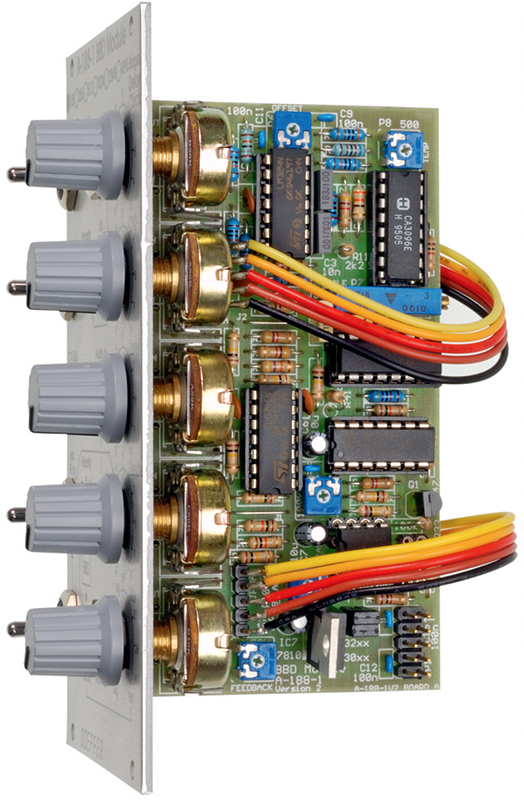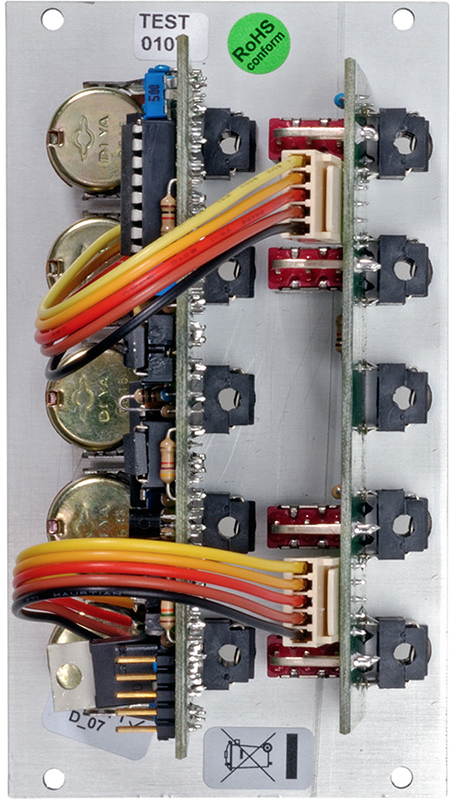A-188-1a (512 stages)
$199.00
Doepfer a-188-1a (512 stages, mn3004/mn3204) BBD
Module A-188-1 is a so-called Bucket Brigade Device module (abbr. BBD). BBDs have been used to delay audio signals before digital delays dethroned the BBD based effect units. But BBDs have some very unique advantages (or disadvantages dependent on the point of view) over the digital counterpart which result from the special properties of the BBDs. BBD circuits can be treated as a chain of Sample&Hold units (S&H) which pass on their voltages to the next S&H in the chain at each clock pulse. A more detailed explanation – including the different types of BBDs – can be found in following chapter.
In any case the sounds generated by module A-188-1 are very special. Typical applications are: Flanger, Chorus, Analog Delay or Karplus/Strong synthesis. But as the A-188-1 has a lot of very unique features (voltage controlled clock rate / delay time with extreme range, polarity switches for the CV inputs, feedback and BBD out/mix, clock and CV output of the high speed VCO, BBD clock input, feedback insert, feedback up to self-oscillation) a lot of unusual applications can be realized with the module (e.g. delay controlled by ADSR, envelope, random or sequencer with positive or negative effect). The A-188-1 also has no built-in anti-alisaing filter in order not to limit the possibilities of the module. For this the CV out is intended.
A more detailed description of the module can be found in the user's manual A1881_man.pdf.
Originally A-188-1 was developed for BBD curcuits with 1024 or 2048 stages as these circuits are still in production. Bur we found a limited quantity of normally obsolete BBD devices with 128, 256, 512 and 4096 stages (MN3006, MN3009/3209, MN3204, MN3005). These are more expensive than the two standard circuits with 1024 and 2048 stages. Therefore the module versions with 128, 256, 512 or 4096 stages are more expensive and available only while stocks last. The BBD type used in the module is indicated by a dot at the front panel. These are the names of the different versions:
- A-188-1X with 128 stages BBD (MN3006/MN3206), available only as long as quantities of MN3006/MN3206 last
- A-188-1Y with 256 stages BBD (MN3009/MN3209), available only as long as quantities of MN3009/MN3209 last
- A-188-1A with 512 stages BBD (MN3004/MN3204), available only as long as quantities of MN3004/MN3204 last
- A-188-1B with 1024 stages BBD (MN3007/MN3207/BL3207), standard version, no delivery limitations
- A-188-1C with 2048 stages BBD (MN3008/MN3208/BL3208), standard version, no delivery limitations
- A-188-1D with 4096 stages BBD (MN3005/MN3205), available only as long as quantities of MN3005/MN3205 last
For the BBD circuits with 128 and 4096 stages the first version of the A-188-1 cannot be used without modifications (additional electronic parts and wires, interrupted pcb tracks). The revised version of the module is delivered since about June 2006 and contains several jumpers to select the desired BBD circuit. If desired we are able to modify the first version of the module for the BBD with 4096 or 128 stages (additional charge).
The above pictures shows the front panel (version 2) and the scheme of the BBD module. These controls and in/outputs are available:
- High speed VCO (HSVCO) section:
- manual delay control
- delay CV input (CV1) without attenuator (about 1V/oct) and polarity switch (negative/off/positive)
- delay CV input (CV2) with attenuator and polarity switch (negative/off/positive)
- turning the manual delay knob clockwise or an increasing the external CV with polarity switch in positive position increases the clock and consequently decreases the delay time (similar to a VCF or VCO, especially because of Karplus-Strong synthesis applications)
- clock output (e.g. to control another BBD, SC-Filter or delay module)
- CV output (e.g. to control a VCF that follows the BBD clock), this voltage is composed of the manual delay control, CV1 and CV2
- BBD/audio section:
- standard versions of the module: 1024 or 2048 stage BBD (choice at order, a mark at the front panel identifies the type of BBD, similar to A-138a/b)
- special versions of the module: 128, 256, 512 or 4096 stage BBD (additional charge, available only while stocks of these special BBD chips last)
- delay range for 1024 stage BBD module: ~ 2.5 ms to ??? (corresponds to max. a clock frequency of ~ 200 kHz)
- delay range for 2048 stage BBD module: ~ 7 ms to ??? (corresponds to max. a clock frequency of ~ 150 kHz)
- the delay ranges for the 128, 256, 512 and 4096 stage versions can be found in the user's manual A1881_man.pdf.
- the max. delay time (???) is not specified as it depends upon the desired quality of the delayed audio signal. The signal becomes more and more poor as the clock frequency is reduced (please refer to the corresponding note below and listen to the audio examples for details)
- external clock input (used to control the module e.g. from an external HSVCO or from another BBD module). The socket is normalled to the output of the internal clock oscillator.
- two audio inputs (connected as a miniature multiple) with attenuator
- BBD output (raw delayed output without original signal, e.g. for external feedback control via other A-100 modules, e.g VCA or VCF), the BBD output is affected by the feedback polarity switch to obtain the polarity function even for external feedback loops
- manual feedback control
- feedback polarity switch (positive/off/negative), affects even the BBD output socket
- external feedback input (the socket is normalled to BBD output)
- BBD signal polarity switch (positive/off/negative)
- mix control (relation between original signal and positive or negative BBD signal)
- mixed audio output
Links to some audio examples are available (with 2048 and 1024 stage BBD devices). The main difference between the two types of BBDs is the delay time range. The maximum clock frequency mentioned in the data sheet of the 2048 stage BBD is 100kHz. This leads to a minimum delay time of about 10ms. But we found that the device is able to operate even a bit beyond this spec (up to ~ 150kHz) causing a minimum delay time of about 7ms. The maximum clock frequency mentioned in the data sheet of the 1024 stage BBD is 200kHz. This leads to a minimum delay time of about 2,5ms. Overclocking is not possible for the 1024 stage BBD.
The maximum (useful) delay time is hard to define. The output becomes more and more crunchy as the clock frequency goes down because the number of samples per second taken from the original signal decreases as the clock frequency is reduced. But this is only one aspect. Indeed several effects occur simultaneously:
- kind of bit crunching because of the increasing time between samples taken from the audio signal
- aliasing effect as the sample rate becomes less than twice the max. audio frequency
- BBD losses: the BBDs are not specified for clock frequencies less than 10 kHz (this value is valid for both 1024 and 2048 stage BBDs). The BBDs can be treated like a chain of sample&hold units with very small capacitors (the capacitors are integrated on the BBD chip). Clock frequencies below 10kHz cause voltage losses as the holding times of the S&Hs are no longer sufficient to pass on the voltages to the succeeding stage without errors/losses.

Manufacturer
Format
Eurorack
Functions
Effect, Delay, BBD
Bus Board Cable Type
N/A
Width
14HP
Power Supply
+-12v
Depth
60mm
Max Current
80mA
CV IO
N/A









